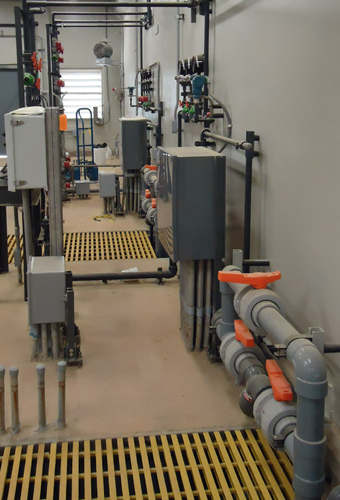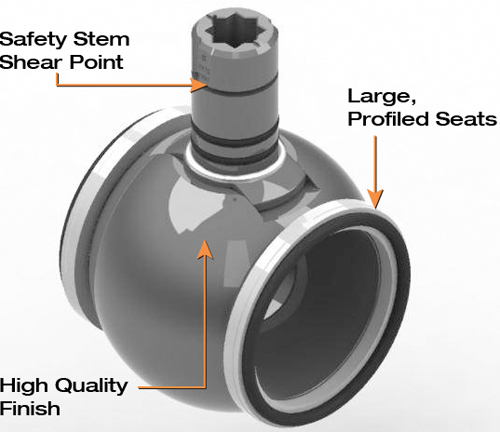Thermoplastic Valves Come With Benefits And Considerations
By Steven Dolejsi, Applications Engineer, IPEX USA, LLC
With advantages like corrosion and chemical resistance, ease of installation, low maintenance, durability, and resistance to scale and bio film build-up, thermoplastic pipe and fittings have become a common choice for water treatment systems. However, there is still a misconception in the industry that plastic pipe is only used for the water distribution applications within a treatment facility.
In fact there are a variety of thermoplastic material options available to suite multiple water treatment applications. High ductility acrylonitrile butadiene styrene (ABS) and polyethylene (PE) piping systems are available for air distribution, including supply to aeration beds. Polyvinyl chloride (PVC), chlorinated polyvinyl chloride (CPVC), and polypropylene (PP) materials offer a wide operating temperature range. They are also highly resistant to acids and chemicals, including ferrous chloride, sodium hypochlorite, hydrogen peroxide, and sodium bisulfate, making these materials ideal for chemical feed and drainage lines.
It is also common to see thermoplastic piping systems used in conjunction with traditional metal valves and antiquated automation controls. However, installing a metal valve in the system can create a potential weak link. This is compounded by the fact that a valve is a mechanical device subject to wear and tear. The same holds true with automation equipment. On the other hand, installing thermoplastic systems with thermoplastic valves eliminates the galvanic and chemical corrosion issues found in traditional materials.
Price vs. Cost
Thermoplastic piping systems are often regarded as a “cheap” alternative to traditional metal options. Much like exotic alloys and lined pipe, these systems should actually be regarded as engineered piping solutions that happen to be more cost effective and easy to install.
While thermoplastics can often have a lower material price than metal, this is not true for all products—particularly with certain configurations of thermoplastic valves. In today’s economy, it is even more important to minimize spending on upgrades, installations, and replacement while maximizing system life and efficiency. The motivation to save often causes people to focus heavily on the price of a product rather than the overall total cost of ownership (TCO) and return on investment (ROI). It is important to consider material price, installation, maintenance, process efficiency, and replacement. Choosing the least expensive option up front can ultimately end up increasing total cost of ownership.
When it comes to selecting the correct valve for an application, the considerations need to span beyond just the material to include the design of the valve. A poorly-chosen or low-quality valve can fail prematurely, costing a facility additional labor and replacement. Some metal valve options may be less expensive than their thermoplastic counter parts. However, they are often harder to install, require extra support to prevent unwanted stress on the system, experience corrosion, and may require more maintenance due to scaling and bio-film build up.
Material Selection
Choosing the right material starts with considering all operating parameters of a system. As previously mentioned, thermoplastics are an engineered piping system alternative. Accordingly, one must choose a material that is compatible with the fluid being conveyed and that will operate at the required pressure and temperature of the system. When selecting the correct valve, it is important to consider the material of construction, the sealing material, and the pressure capabilities. It is also good practice to take into consideration the surrounding atmospheric conditions. For example, chemical vapor or high humidity in the air surrounding the valve could create external corrosion issues.

WTP chemical feedline
The most readily available elastomers available are Ethylene propylene diene monomer (EPDM) and fluorocarbon (FPM/FKM), but some valves will also have PTFE lined or encapsulated elastomers. Incorrect selection of a sealing material can cause valves to leak, seize, or fail prematurely.
When checking the compatibility of a piping, valve, or sealing material to the service fluid, it is important to consider both the chemical concentration and the operating temperature. Just because a material is compatible at 73°F, that does not mean it will be compatible at 120°F. Make sure to consider material compatibility for all the components of a valve that will come into contact with the service fluid. If the valve has internal metal components that will also be exposed to the fluid, the compatibility of those metal components with the service fluid should be determined.
Valve Selection
Similar to metal valves, a variety of thermoplastic valve options are available. Selecting the right type of valve depends on the service and application required.
Ball valves are most commonly specified and used for on/off service. Profiled ball valves are available for throttling applications. Although the flow pattern is more linear than a standard ball valve due to the specifically designed ball profile, flow control is still not as precise as can be achieved with a diaphragm or globe valve. Ball valves are not appropriate for dirty fluids that contain grit since sediment in the fluid will damage the ball and seat. They are also not ideal for volatile fluids that give off gas, such as sodium hypochlorite or sodium hydroxide. When a ball valve is in the “off” position, fluid is entrapped in the ball. Off gassing may occur in the entrapped fluid that can exceed the pressure holding capabilities of the valve and cause catastrophic failure. If ball valves are used for the conveyance of volatile fluids, they must be vented to allow the gas to dissipate into the line. Venting a ball valve is achieved by making a small hole on the upstream side of the ball.
To maximize operating life, especially in high-cycle applications, it is important to install valves with high-quality finishes such as smooth internal components and large profiled PTFE seats and elastomer seals. This will eliminate premature wear of the sealing components and thereby reduce maintenance and replacement costs. In a chemical feed system, it is important to select a ball valve with a safety stem that will fail above the O-ring seal. Should the valve seize or be over-torqued, this will eliminate the possibility of hazardous fluids escaping the valve body and possibly injuring workers.

Butterfly valves are ideal for on/off service and can be used for throttling as well. They will operate with dirty fluids containing sediment. If used in a service with dirty fluid, installation orientation is important. The valve should be installed on a 45- or 90 -degree angle to prevent sediment from building up at the lower shaft seat and causing excessive wear. It is important to select a butterfly valve with a profiled liner for minimized breakaway torque and a non-wetted shaft so that additional compatibility or corrosion does not need to be considered.
Diaphragm valves are ideal for dirty fluids and can be used for throttling. The design of these valves allows them to be used in high cycle applications without wear on sealing surfaces. Because their open-to-close cycle is greater than 90 degrees, they can be used for more precise throttling than ball or butterfly valves. In the closed position, there is no entrapment of fluid within the valve body; this means that diaphragm valves are a good choice for volatile fluids that give off gas.
Check valves come in a variety of configurations, the most common being ball, piston, and swing check. Swing checks come in multiple configurations and are ideal for horizontal large-diameter, high-capacity pipe lines. Ball check valves are ideal for vertical service but can be used horizontally. When used horizontally, there must be enough back pressure generated to force the ball to seal since there is no assistance from gravity. Spring-assisted options exist to negate this problem but create corrosion and maintenance concerns. Piston check valves are ideal for both vertical and horizontal applications since the piston is oriented at a 45-degree angle to the fluid direction.
It is not recommended to install thermoplastic valves near a pump. The vibration from a pump and cyclic fluid pressure may cause premature wear on components or loosening of threaded components. If possible, it is recommended to isolate pump vibrations and install check valves further down the line where fluid characteristics have developed into a more consistent full turbulent flow.
Automation Selection
Antiquated automation systems often feature large, heavy, metal construction that is prone to corrosion and operating failures. The components for these systems are often hard to come by and ongoing maintenance and repair escalates total operating costs. Thankfully, there are many corrosion resistant valve automation options available today.
When selecting an automation package for thermoplastic valves, it is important to consider the corrosion resistance of the actuator itself in case there is high moisture content in the air or chemical vapors.
Size also matters. Thermoplastic systems cannot support the same amount of weight as metal systems. Excessive weight will create undue stress on the valve, its sealing components and all associated pipe and fittings. Minimizing the weight of automation components will mean less stress on components and fewer supports needed. It is important to support all equipment installed in a thermoplastic system.
When selecting the correct actuator, consider the cycle time—not only for the process, but for the effect on the thermoplastic system. Thermoplastics can be damaged by water hammer or large pressure surges. Therefore if selecting a pneumatic option, consider installing speed controllers that will slow down cycle times.

Conclusion
As thermoplastic pipe and fittings become standard for water treatment systems, it makes sense to also consider the use of thermoplastic valves and automation—even if upfront costs seem higher. Traditional metal options can increase TCO with higher maintenance and replacement costs over the life of the system. In contrast, thermoplastic solutions eliminate galvanic and chemical corrosion issues that can cause issues for metal valves.
While the selection of the material, valve type and automation system must be taken into consideration with any valve, thermoplastic piping systems are an engineered alternative with the potential to lower overall costs and improve operating life for a variety of water treatment and chemical feed systems.
Steven Dolejsi is an Applications Engineer with IPEX USA, LLC in Mississauga, ON. Steven received a B.S. degree in Mechanical Engineering from Ryerson University. He has over 7 years of experience in thermoplastic piping system design and application and has assisted in material selection and design for multiple water and wastewater treatment facilities across the United States.
